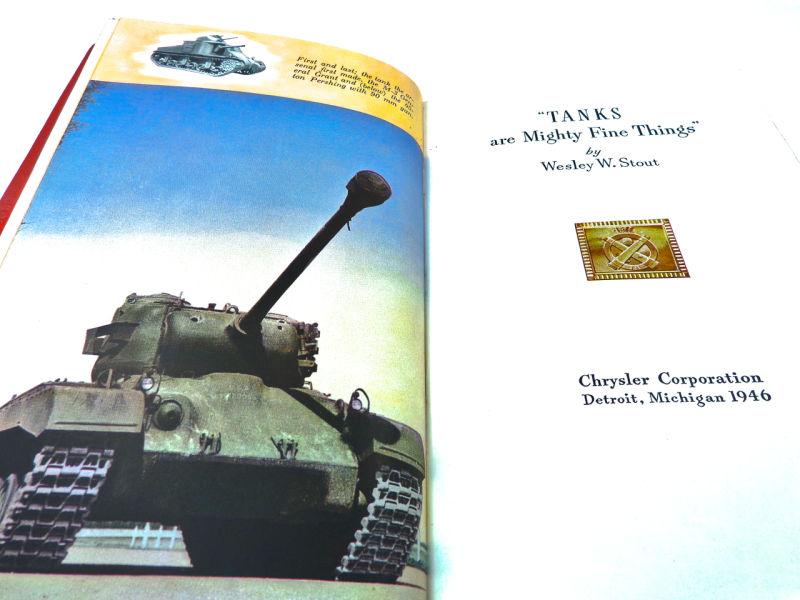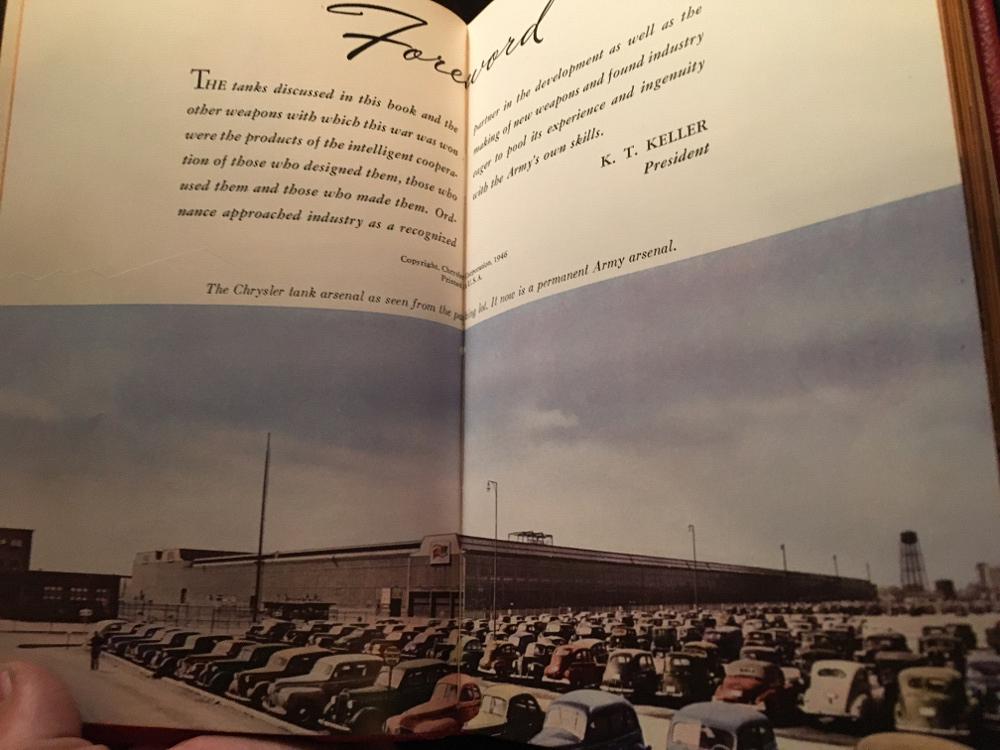Owner, Brown Dog Welding
- FMA
- The Fabricator
- FABTECH
- Canadian Metalworking
Categories
- Additive Manufacturing
- Aluminum Welding
- Arc Welding
- Assembly and Joining
- Automation and Robotics
- Bending and Forming
- Consumables
- Cutting and Weld Prep
- Electric Vehicles
- En Español
- Finishing
- Hydroforming
- Laser Cutting
- Laser Welding
- Machining
- Manufacturing Software
- Materials Handling
- Metals/Materials
- Oxyfuel Cutting
- Plasma Cutting
- Power Tools
- Punching and Other Holemaking
- Roll Forming
- Safety
- Sawing
- Shearing
- Shop Management
- Testing and Measuring
- Tube and Pipe Fabrication
- Tube and Pipe Production
- Waterjet Cutting
Industry Directory
Webcasts
Podcasts
FAB 40
Advertise
Subscribe
Account Login
Search
The Arsenal of Democracy—When Detroit bailed out the U.S. government
- By Josh Welton
- May 2, 2016
Years ago my wife Darla and I were walking around downtown Mount Clemens, Mich., to take in the Stars and Stripes festival. It’s a ginormous potluck of a patriotic event, with rock and roll bands, Army recruiters, food trucks, and fireworks.
North of Main on Macomb Place, on a side street typically reserved for salons, rented office space, and craft shops, there was a “pop-up” museum, a small, military museum opened mostly to solicit donations toward the construction of a permanent home.
The museum felt more like an antique mall, with half of the war-time memorabilia for sale and half just for display. Amongst the aged uniforms, propaganda posters, and weaponry, there was a set of books that snagged my attention. They weren’t behind glass. While I was fingering through several of the volumes, one of the curators approached, keen to the fact that I was pretty stoked at what I was taking in.
The books were part of a larger set, he explained. Sometimes of two, occasionally four or five, and rarely, very rarely, all seven. In fact, I’m pretty sure when the museum attendant educated me on the collection he told me there were only six books, and that they were borderline impossible to find all at once.
“Tanks are Mighty Fine Things” (Figure 1) was mostly what I’d been glancing at. In the mid-to-late 1940s, Chrysler president K.T. Keller commissioned former Saturday Evening Post editor Wesley C. Stout to put out a series of books chronicling the ingenuity, engineering, and brute strength that the Chrysler Corporation and American people put forth to bolster the Arsenal of Democracy. It took me a few years to find the entire series of seven books (Figure 2), a difficulty that in and of itself is something, considering the times we live in. Not only did I find it, but it’s a first print, first edition matching bibliotheca of seven in really good condition.
As a millwright who also went through his apprenticeship at Chrysler; a driver/mechanic for General Dynamics (formerly Chrysler Defense), who gets to take an Abrams around the test track every now and then; as a fabricator who builds prototype military parts; and an artist who enjoys repurposing metal, it’s cool to see how my worlds collided so many decades ago to help win WWII.
When I contemplate the monumental undertaking that U.S. manufacturing embarked on 70 years ago, it’s hard to fathom. I wonder if the people who were so adamant that the government should deny Chrysler assistance through the last financial crisis would feel the same way if they truly understood that without the wartime engineering, testing, and production of Detroit manufacturers, without the resources Detroit and Middle America poured into the war effort—efforts that went far above and beyond what possibly could have been expected of them (and the speed at which they did it)—the outcome of WWII could have been much different.
That, and after the war Chrysler voluntarily returned $50,000,000 to the government. They even built the tank arsenal before funds were secured, and in the end they did all the legwork, R&D, and building of the Detroit Tank Arsenal for the grand sum of $4. That’s all in mid-century dollars.
Former Chrysler President K.T. Keller wrote the foreword to each book (Figure 3). It’s of interest to note that while “common knowledge” is that America and its Allies came out on top because of pure production, that wasn’t necessarily true. Before “The Great Detective” Keller quoted German Grand Admiral Doenitz, after his capture and in regards to radar: “We fell behind technically. We were unable to build short wave radar to compete with the Anglo-American improved radio location equipment.”
I haven’t read all the books thoroughly, though I need to. A quick thumbing through always provides a smile, like in the book “Secret,” where Stout described the invention of the Atom bomb (ok, maybe smile is the wrong word, considering the subject, but you get it). Chrysler (or the Corporation as it’s often referred to) needed disguised office space, so it rented out a couple of floors of a building on Woodward in Detroit. Bonds sales were on the first floor, and it provided a hidden entrance to the Chrysler’s X-100 personnel in the floors above. In my mind, I picture Archer walking through the laundromat to his spy headquarters.

Figure 2: Complete set of books written by Wesley C. Stout about bolstering the Arsenal of Democracy.
There’s an obvious tone of propaganda, and even racism, in the books. Keller wanted the world to know how much his people sacrificed to win the war, and wounds were still fresh. Keeping that in mind it’s still mindboggling to review.
The Dodge-Chicago aircraft facility and its 19 buildings comprised 6.3 million square feet. When the legendary architect Albert Kahn was called in to design the additional buildings, he came up with a concrete element that saved 2.9 lbs of reinforcing steel for every square foot of building and completely eliminated structural steel from the plans. This alone allowed for the raw metal to make 14 more flying Superfortresses.
“Bullets by the Billions” (Figure 4) is about a plant in Evansville, Ind., that went from producing Plymouth cars and Dodge trucks with a workforce of 650 people to building, literally, billions of 0.45 cartridges and hundreds of thousands of other bullets with workers numbering more than 13,000. On the side, they repaired thousands of Sherman tanks and military trucks.
From the genius of some Americans to the incredible labor of others, these books are a humbling reminder of how tenacious we can be when backed against a wall.
All images provided by Josh Welton, Brown Dog Welding.
subscribe now

The Fabricator is North America's leading magazine for the metal forming and fabricating industry. The magazine delivers the news, technical articles, and case histories that enable fabricators to do their jobs more efficiently. The Fabricator has served the industry since 1970.
start your free subscriptionAbout the Author

- Stay connected from anywhere

Easily access valuable industry resources now with full access to the digital edition of The Fabricator.

Easily access valuable industry resources now with full access to the digital edition of The Welder.

Easily access valuable industry resources now with full access to the digital edition of The Tube and Pipe Journal.
- Podcasting
- Podcast:
- The Fabricator Podcast
- Published:
- 04/16/2024
- Running Time:
- 63:29
In this episode of The Fabricator Podcast, Caleb Chamberlain, co-founder and CEO of OSH Cut, discusses his company’s...
- Industry Events
16th Annual Safety Conference
- April 30 - May 1, 2024
- Elgin,
Pipe and Tube Conference
- May 21 - 22, 2024
- Omaha, NE
World-Class Roll Forming Workshop
- June 5 - 6, 2024
- Louisville, KY
Advanced Laser Application Workshop
- June 25 - 27, 2024
- Novi, MI

































